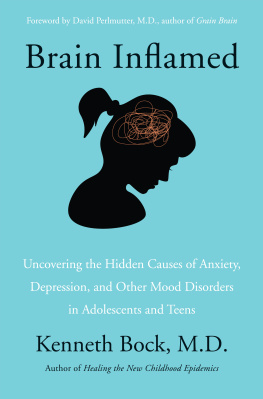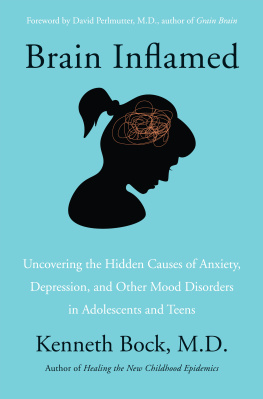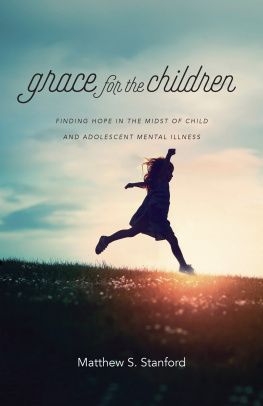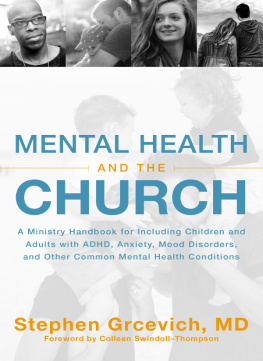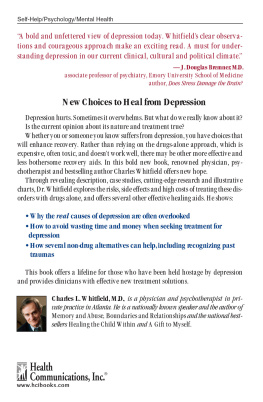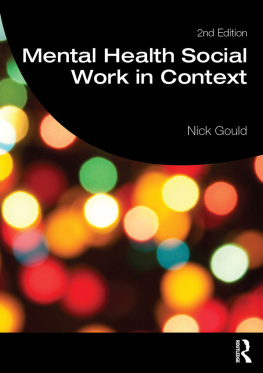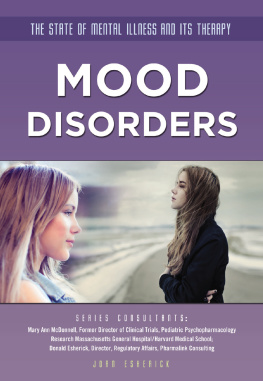Contents
Guide
This book is dedicated to the memory of my best friend, my buddy David Marell (19452019), the quintessential Teen Whisperer. I miss your friendship, wisdom, and counsel, and the thirty-five years of laughter and love we shared, every day.
Contents
Ive known Kenneth Bock for decades, and in that time, Ive continually watched him diagnose medical mysteries that have stumped many other practitioners. His interventions have altered the trajectory of his patients lives and have truly improved outcomes for so many kids suffering from psychological disorders. His skill lies in his ability to accurately home in onand treatthe root causes of the problem. As you will soon learn, many of the conditions that present in adolescents and teens as psychological in nature are, in fact, physiological. Such conditions are, at least in part, a result of chronic, systemic inflammation that has traveled to the brain.
Inflammation is a fundamental biological process that is essential for our survival. It is inflammation and its myriad expressions that allow our bodies to respond to confrontations from potentially harmful interactions with pathogenic organisms, toxins, traumatic events, and other circumstances that have the potential to prove threatening.
But over the last several decades it has become clear that this life-supportive inflammatory response may persist unchecked and actually pave the way for damaging events across a wide spectrum of bodily tissues. We now recognize that so many of our most pervasive, chronic, degenerative conditions are united in terms of their causation by persistent, unrestrained inflammation. Inflammation is now recognized as playing a central role in coronary artery disease, type 2 diabetes, Alzheimers disease, depression, and even cancer. So, clearly, we need to explore the role of inflammation in the human body as being far more nuanced than simply friend or foe.
Whether supportive or destructive, the inflammatory response is certainly complex. And while the common initiators described above are generally well understood, what is less universally appreciated is the role of lifestyle choices in regulating inflammation and its downstream effects. Our white blood cells and the various chemical mediators they produce are deeply involved in the inflammatory process, and they can of course be activated by a bee sting or an infection in the skin. But fundamental to the new understanding of the role of persistent inflammation in so many chronic debilitating conditions is the recognition that these very same pathways may be triggered into action by our daily decisions, including inappropriate food choices, lack of restorative sleep, chronic stress, and sedentariness.
This important relationship between our day-to-day choices and the set point of inflammation, coupled with the role of inflammation as a causative factor in so many of our most feared medical conditions, is empowering, as it means that in a very real sense each of us can take control of our health destiny when we make good lifestyle choiceschoices that ultimately bring us benefit through modulation of inflammation. And well beyond diseases, the actual process of aging itself is now being looked upon as a manifestation of ongoing inflammation, so much so that the term inflammaging has now entered the scientific lexicon.
Reining in chronic degenerative conditions and targeting the aging process are ideas that have appeal to those of us who are getting on in our years. Thats for sure. But, more important, it is only very recently that scientific research has similarly linked inflammation to some of the most widespread and certainly challenging health issues facing a younger segment of our population, the adolescent. Mental health problems, including anxiety, depression, and other mood disorders, are rampant in school-age children, and the response for dealing with these issues from health-care providers is, more often than not, pharmaceutical. Were it not for their general lack of efficacy and significant side-effect profiles, drugs for kids might seem like a good option. But the most obvious flaw with this approach is that focusing on a pharmaceutical intervention in this context generally means ignoring the underlying cause or causes of the issue at hand.
Gaining an understanding of what underlies mental health issues in adolescents allows parents and health-care providers to focus on the fire, not just the smoke. And inflammation is a good place to start. In the pages that follow, Dr. Kenneth Bock takes us on a journey through a vast array of potential candidates that may be working individually or in concert to amplify the production of inflammatory chemicals in the bodies and brains of adolescent children. And whether addressing thyroid function, blood sugar, Lyme disease, food allergy, or even toxic exposure, Dr. Bock reveals that a final common pathway toward mental health disturbance that is shared by these seemingly disparate avenues is amplification of the inflammatory response. As such, Brain Inflamed explores why inflammation is enhanced and then reveals how to bring about its resolution with the goal of resolving the mental health issue that represents its manifestation.
But, most important, the following text imparts the compassion of a medical doctors decades of a goal-focused endeavor to bring about solace for adolescents and their families who are challenged and looking for hope.
David Perlmutter, M.D., August 2020, aboard Mystic Eagle, British Columbia, Canada
Ive seen a lot of complex cases over the thirty-five years Ive been a practicing physician, twenty of which have been focused on childrens health. Its enough that Ive become known as a bit of an expert in helping people who might otherwise fall through the medical cracks. And over the last decade, the number of children who fit this description have grown more than I would have predicted. Increasingly, I have patients whose emotional volatility, low energy, and anxiety negatively affect their school performance, friendships, and even their cognition. Those are often my relatively mild cases. Others exhibit tics or signs of obsessive-compulsive disorder (OCD). By the time some kids get to me, theyve often been diagnosed with a psychiatric disorder and been prescribed multiple psychotropic medications, from antianxiety drugs and antidepressants to stimulants and antipsychoticsand some of them arent even in the fifth grade. Im also seeing an uptick in severe cases of mood disordersmore persistent, more extreme, and often more harmful examples of the conditions above, like severe depression, bipolar disorder, and rapid cycling mood swings. These kids arent sad and surly, theyre literally pulling out clumps of their mothers hair. Their handwriting deteriorates. Their attention wanders. They isolate themselves and sometimes become self-injurious. Their parents come in aghast that their sweet, well-behaved children have transformed into raging, aggressive bullies or frightening, morose aliens, sometimes literally overnight.
Im not the only one noticing a shift. Just read the headlines. Anxiety and depression have repeatedly been heralded as a national scourge of the tween and teen years and been featured on the covers of Time and the New York Times Magazine. While the diagnostic criteria for anxiety, depression, OCD, and post-traumatic stress disorder (PTSD) changed a little in the last update of the Diagnostic and Statistical Manual of Mental Disorders (DSM-5), the principal classification system used by psychiatrists, it wasnt enough to explain the increasing prevalence of these diagnosed mental health disorders in our tweens and teens. Yet a 2016 Child Mind Institute report announced that One in five children suffers from a mental health or learning disorder, and 80 percent of chronic mental disorders begin in childhood. According to the National Institute of Mental Health, half of our adolescents have been diagnosed with a mental disorder, and of that half, about 20 percent will find it severely disruptive to their lives.

